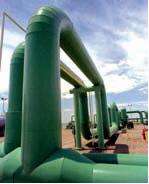Hydrogen pipeline transport

Hydrogen pipeline transport is a transportation of hydrogen through a pipe as part of the hydrogen infrastructure.
History
- 1938 - Rhine-Ruhr The first 240 km (150 mi) hydrogen pipes that are constructed of regular pipe steel, compressed hydrogen pressure 210–20 bars (21,000–2,000 kPa), diameter 250–300 millimetres (9.8–11.8 in). Still in operation.[1][2]
- 1973 – 30 km (19 mi) pipeline in Isbergues, France.[3]
- 1985 - Extension of the pipeline from Isbergues to Zeebrugge
- 1997 - Connection of the pipeline to Rotterdam
- 1997 - 2000: Development of two hydrogen networks, one near Corpus Christi, Texas, and one between Freeport and Texas City.
- 2009 - 150 mi (240 km) extension of the pipeline from Plaquemine to Chalmette.[4]
Economics

Hydrogen pipeline transport is used to transport hydrogen from the point of production or delivery to the point of demand. Although hydrogen pipeline transport is technologically mature,[5][6] and the transport costs are similar to those of CNG,[7] most hydrogen is produced in the place of demand, with an industrial production facility every 50 to 100 miles (80 to 161 km)[8]
Piping
Hydrogen has problems with both hydrogen embrittlement and corrosion. Hydrogen has an active electron, and therefore behaves somewhat like a halogen.[9] For this reason, hydrogen pipes have to resist corrosion. The problem is compounded because hydrogen can easily migrate into the crystal structure of most metals.[10] For metal piping at pressures up to 7,000 psi (48 MPa), high-purity stainless steel piping with a maximum hardness of 80 HRB is preferred.[11]
Composite pipes are assessed like:
- carbon fiber structure with fiberglass overlay .
- perfluoroalkoxy (PFA, MFA).
- polytetrafluoroethylene (PTFE)
- fluorinated ethylene propylene (FEP) .
- carbon-fiber-reinforced polymers (FRP)
Fiber-Reinforced Polymer pipelines (or FRP pipeline) and reinforced thermoplastic pipes are researched.[12][13][14][15]
Infrastructure

- 2004 - USA - 900 miles (1,400 km) of low pressure hydrogen pipelines[16][17]
- 2004 - Europe - 1,500 km (930 mi) of low pressure hydrogen pipelines.[18]
Gallery
|
See also
- Guided rotor compressor
- HCNG
- Hydrogen economy
- Hydrogen infrastructure
- Hydrogen leak testing
- Hydrogen station
- Hydrogen turboexpander-generator
- Pipeline transport
- Plastic pressure pipe systems
- Timeline of hydrogen technologies
- Tubing (material)
References
- ↑ The Technological Steps of Hydrogen Introduction - pag 24
- ↑ rise.org - Pipelines
- ↑ 2006 - vector of clean energy - pag 15
- ↑ Hydrogen Pipeline Extension Strengthens Gulf Coast Network
- ↑ 2005 DOE Hydrogen Pipeline Working Group Workshop
- ↑ Natural gas pipelines for hydrogen transportation
- ↑ 2006 - Compressorless Hydrogen Transmission Pipelines
- ↑ Every 50 to 100 miles
- ↑ Stuart Island Energy Initiative Website Accessed 2010-10-13
- ↑ Stuart Island Energy Initiative Website Accessed 2010-10-13
- ↑ Idaho national Engineering Laboratory Recommendations for Piping for Gaseous Hydrogen Accessed 2010-10-13
- ↑ 2007 - Fiber Fiber-Reinforced Polymer Pipelines
- ↑ NEW, COMPOSITE POLYMERIC/METALLIC MATERIALS AND DESIGNS FOR HYDROGEN PIPELINES
- ↑ 2006 FRP Hydrogen Pipelines
- ↑ Lifetime Simulation Composite & Multilayer Pipelines
- ↑ 2004 USA pipelines
- ↑ 2008 Argonne National Laboratory report
- ↑ 2004 EU pipelines
External links
- Hydrogen Transport by Pipeline
- Idaho national laboratory
- Composite
- (ASME B31.12)
- Hydrogen Embrittlement group
